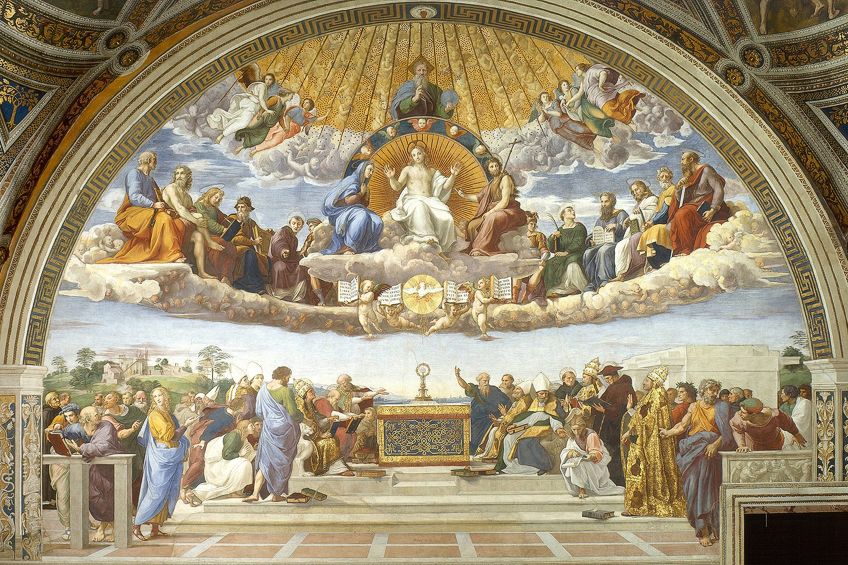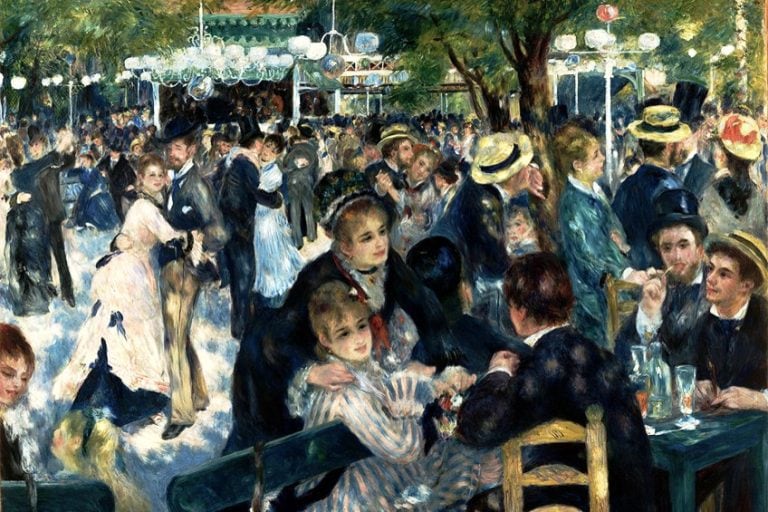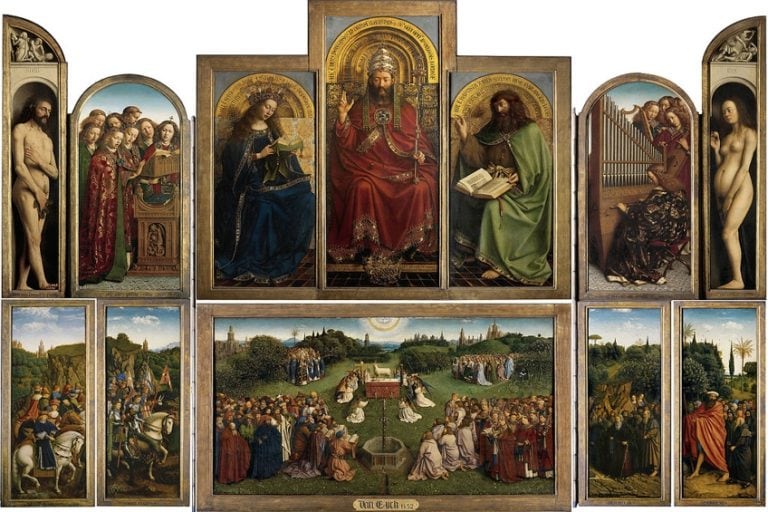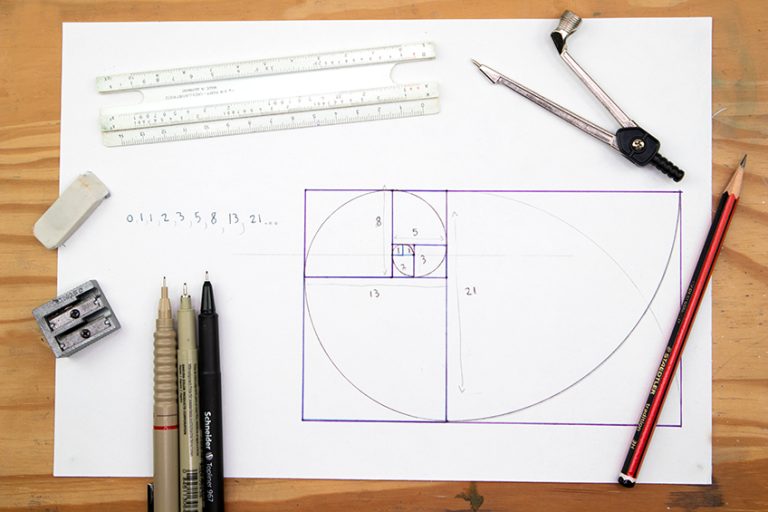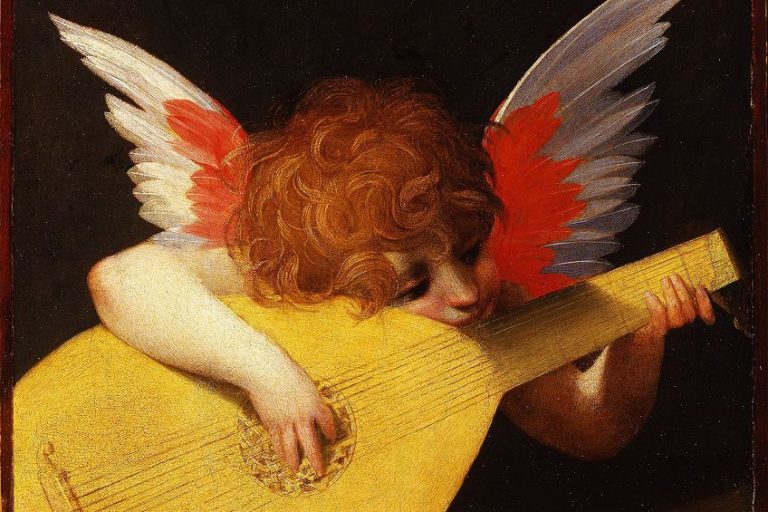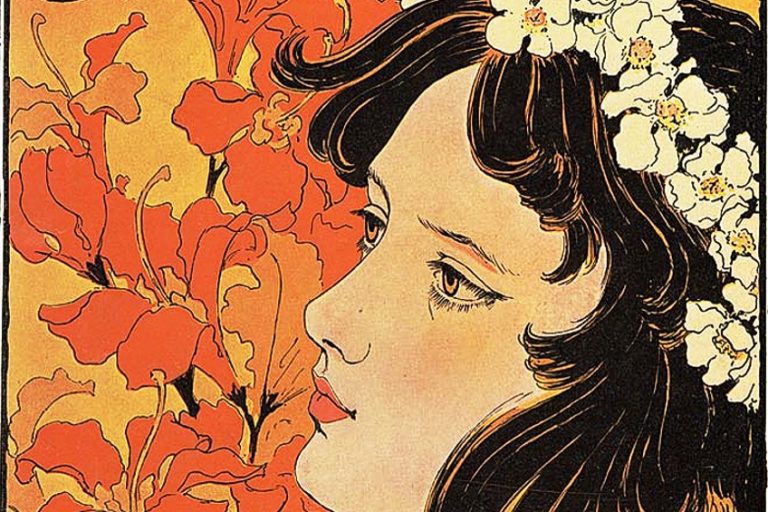Renaissance Art – Europe’s Cultural Rebirth
We all have an idea of the importance of the Renaissance era in European history, and the age of innovation and enlightenment that so characterizes it. The art that came from this time is still among us today, from revivals in pop culture to the originals housed in art galleries all over Europe. If you are interested in this part of history and wondering what the Renaissance art period was all about, what characterized it, and where it took place, this overview will provide you with all you need to know.
What Was the Renaissance?
Before we begin, let us take a brief look at the Renaissance meaning and where it fits within a broader historical context. Renaissance is a French word, deriving its origins from the Italian word rinascita, which means “rebirth”. The Renaissance era was a period of rebirth in almost all the cultural and societal faculties and institutions throughout Europe, including art, science, mathematics, technology, philosophy, religion, and politics, to name a few.
The Renaissance time period had its starting point in Florence, Italy, during the 1300s (14th Century), soon after the Medieval period in Europe. The Medieval period is characterized as being a darker time in Europe’s history, and is often referred to as the Dark Ages because of the various socio-economic and political upheavals.
When we look at the contrast between the Medieval era and the Renaissance, it can seem like a dark versus light period in history. The Renaissance evolved new ideas and concepts and birthed many great human beings who contributed their talents and money to the era’s fame and fortune throughout history.
Read More About the Renaissance Art Period
- Early Renaissance
- High Renaissance
- Northern Renaissance
- Italian Renaissance Art
- Mannerism
- Renaissance Humanism
- Harlem Renaissance Art
- Famous Renaissance Paintings
- Famous Renaissance Artists
Humanism
One of the new ideas and concepts that emerged during the Renaissance was Humanism. This was a philosophical thought or intellectual movement during the 1300s that influenced the way people perceived themselves and God in relation to the world. It also informed a new approach towards visual arts and subject matter, providing a main framework towards the overall Renaissance meaning.
The Humanism philosophy placed man at the center of the universe, so to say. It believed in the inherent capabilities of man as a creative force. This was wholly different from how things were done according to the Catholic church, who had most of the power and say over man’s place in the universe.
Humanism focused on the learning of various fields of the humanities, known as studia humanitatis. For example, these included disciplines like rhetoric, languages, grammar, literature like poetry, philosophies, and various others. It was a time of new discoveries and exploration by man, both figuratively and literally.
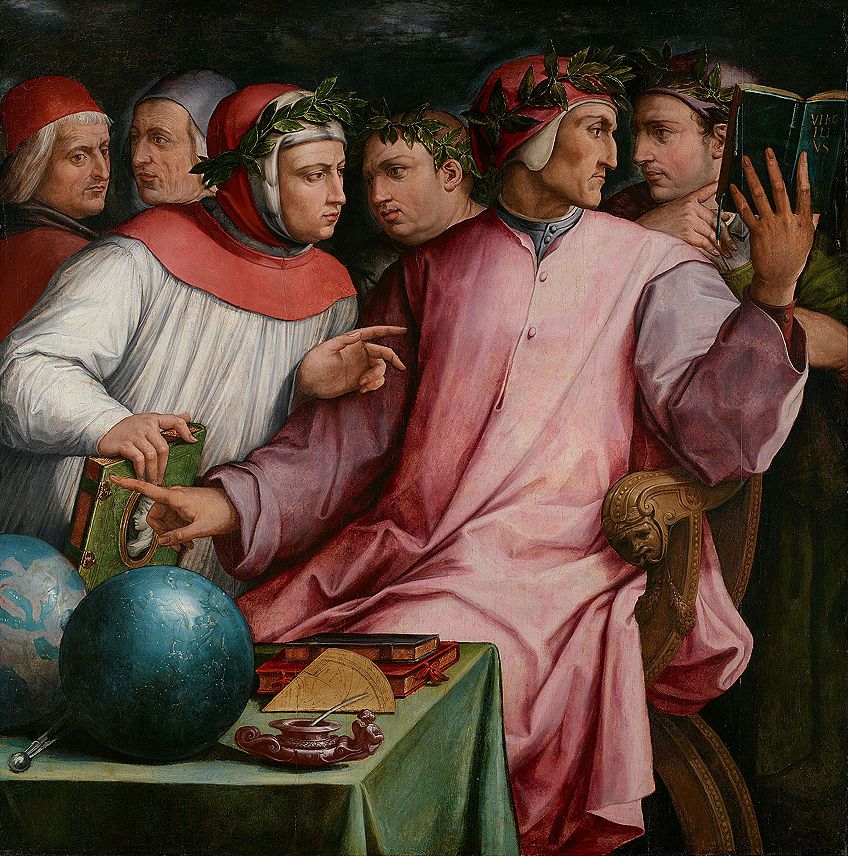
Classical Antiquity
Another important concept in the Renaissance time period was the return to Classical Antiquity, being the Greek and Roman ideals. The Greeks sought to emulate beauty, harmony, and symmetry or perfect proportions in their art. This was also called Realism, which depicted the human form with anatomical correctness. This was different from the more abstracted, idealized forms of human figures from the preceding Byzantine art period.
Greek and Latin literature also became important reading material and intellectual resources that influenced Renaissance scholars and philosophers. The work by the Roman architect, Vitruvius, from the 1st Century BC offered insights on applying mathematical proportions to painting and human anatomy.
The Medici Family
The Renaissance would not have been the same without the Medici family. They were wealthy Italian bankers who ruled Florence during the 1400s, starting under Cosimo de’ Medici. The Medici Bank, established in 1397 to 1494, was the largest bank in Europe, which gave the Medici significant respect and status in society.
Furthermore, the Medicis were important patrons of the arts during the Renaissance period in Florence, and commissioned various artists and provided financial support to establishments like libraries in favor of developing arts and culture. Cosimo de’ Medici was also an avid art lover and collector.
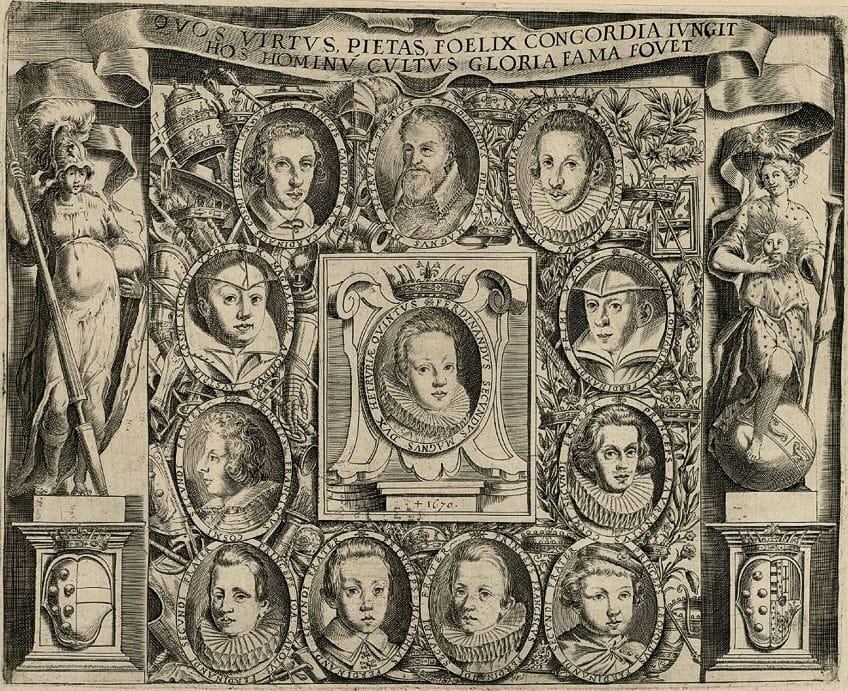
The Development of Renaissance Art
Some historical context of the Renaissance time period will help us to better understand the development of art during this period in European history. There are different characteristics that define Renaissance art, be it paintings, sculpture, or architecture – the dominant art forms during this time. There are also several Renaissance timelines that categorize art, we will discuss these in more detail below, including the most prominent artworks from each period.
Renaissance Art Characteristics
There are several primary characteristics that help us understand Renaissance paintings and other modalities like sculpture and architecture. These all contribute to the aesthetics, the way colors and light are utilized, and the correctness of the proportions portrayed in these compositions. Some characteristics include concepts like Naturalism, Contrapposto, Chiaroscuro, and One-Point Perspective, otherwise known as Linear Perspective.
Naturalism
Naturalism evolved from the development of how artists studied the human form. It was depicted with more realism, appearing more true to nature. Human anatomy was better understood by some artists by studying dead bodies, which created even more realistic portrayals of muscles and limbs.
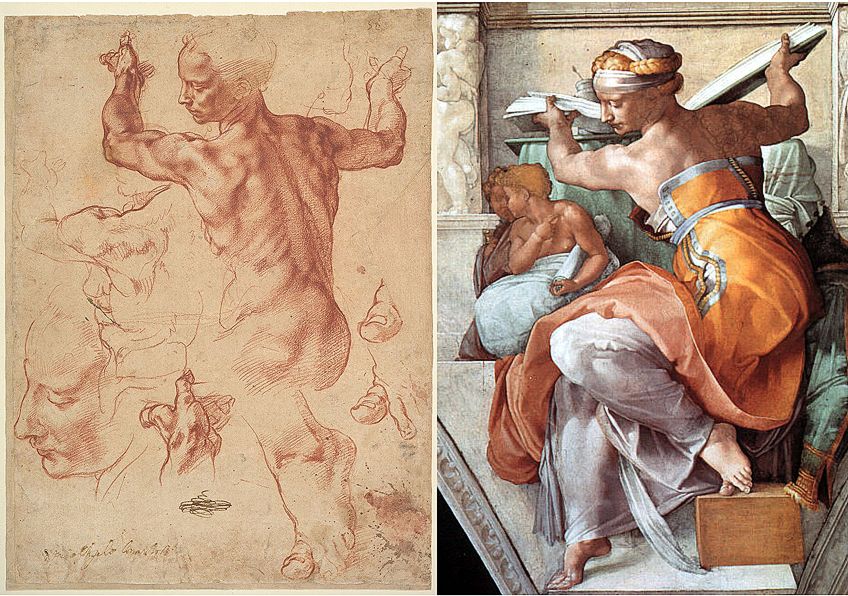
Contrapposto
Contrapposto was another technique employed by many artists, which enhanced the realism of figures and the way they stood, making the composition more fluid and life-like. This technique originally started during the Classical era and was rebirthed during the Renaissance era once again. It is often compared to the flatter and more vertical portrayals of figures from previous art periods.
Contrapposto is an Italian word, meaning “counterpoise”. This is depicted by the body standing with one hip higher than the other, and with more weight on one foot than the other. This gives a characteristic “S” curve throughout the whole body’s posture.
This technique is often described as dynamic and gives the figures a more relaxed disposition.
Chiaroscuro
Chiaroscuro is another Italian word, meaning “light-dark”. It involves the play between color contrasts of light and dark, which creates a three-dimensional effect as well as a heightened emotional intensity. It also adds to the realism of the composition as it depicts light and shadows.
Sfumato
Sfumato also comes from Italian origins, with meanings related to the word smoky, soft, or blurry. This technique was used to blur colors from light to dark so that they combined into a haziness, thus giving the idea of the illusion of space or form. It was also used to blur lines and borders so that the composition appeared more natural. This technique was often utilized in landscapes for backgrounds and to create what is termed an “atmospheric” effect on facial features.

Linear Perspective and the Vanishing Point
Linear perspective (also called one-point perspective) and the vanishing point were two important techniques that were widely utilized to create a sense of three-dimensionality in paintings. This was a revolutionary technique, and it gave artists the ability to create new spaces within compositions and elevate the stature of their art to new levels, quite literally and figuratively, as well as illusionistically.
The Italian architect Filippo Brunelleschi pioneered this technique during the early 1400s.
Brunelleschi discovered that linear perspective consisted of parallel lines (orthogonal and transversal) that converge with a horizon line that meets at a vanishing point in the distance. This technique also gave rise to the idea that each painting is viewed by a single viewer, because there is only one viewpoint to the painting. This was contrasted by Medieval art, which depicted compositions from multiple viewpoints.
The Chronology of Renaissance Art
Renaissance art is categorized into several timelines or phases, namely, the Proto-Renaissance, the Early Renaissance, the High Renaissance, as well as other regions outside Italy, which is collectively referred to as the Northern Renaissance.
The Renaissance dates are also distinguished by different Italian names related to the year.
The Renaissance began in around the 1300s, with what was called the Trecento period, the Italian word for “300”. The period from the 1400s is called Quattrocento, meaning “400”, and the 1500s is called the Cinquecento period, meaning “500”. There were many great artists in each art phase, as well as a notable few who pioneered their medium and techniques, leaving their names to remain etched in Renaissance history. Below, we look at each Renaissance phase, including the prominent artists and paintings related to each.

Proto-Renaissance
The Proto-Renaissance period is also known as the Pre-Renaissance period, and it started around 1300 to 1425. This period was still markedly Byzantine in style with iconographic and idealistic portrayals of religious subject matter, which was also more two-dimensional and flatter in appearance. However, there were some artists that explored different modes of portrayal beyond what was expected from Medieval art of the time.
There were two important artists during the Proto-Renaissance period, namely Cimabué and Giotto. Both artists are known for having produced artworks where the compositions appeared more naturalistic, reminiscent of the Classical era’s realism.
Looking at the work of these two artists will create a contextual framework for the early Renaissance period.
Cimabué (c. 1240 – 1302)
Cimabué, otherwise named Bencivieni Cenni di Pepo, was a Florentine artist considered to be one of the pioneering painters to veer away from the Byzantine style. While there are minimal paintings left behind confirmed to be done by Cimabué, there are many reportings that this artist is the creator of many other painings.
The mosaic in the Pisa Cathedral, Christ Enthroned with the Virgin and St. John (1301 to 1320) is known as the last work created by Cimabué, with records of payments stating so. Other frescoes are reported to be by the artist too, for example, Santa Croce Crucifixion (1287 to 1288) and the Maestà (c. 1280).
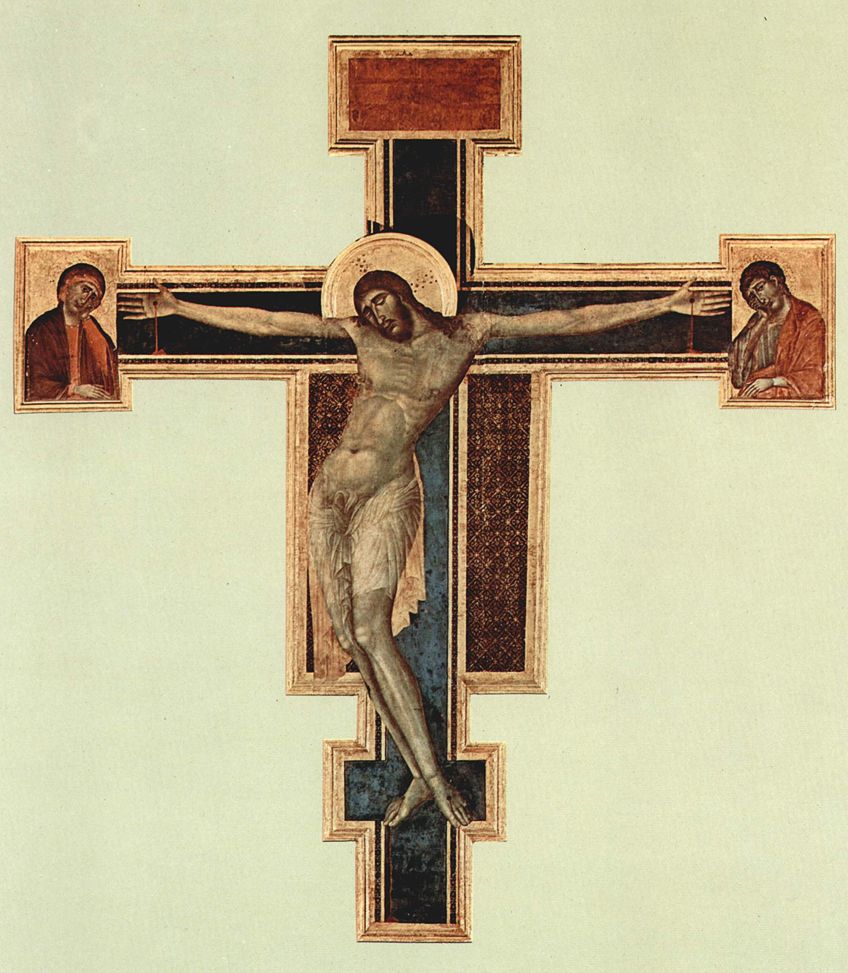
The Santa Croce Crucifixion is one of Cimabué’s artworks that depicts a naturalistic Christ figure on the cross. We see his body in a characteristic contrapposto “S” curve. His skin is also painted in a realistic manner, as described by some sources as “softer” in appearance compared to the paintings from the Byzantine era.
There is a new emotive expression inherent in this painting, which made it a precursor to the Renaissance.
Giotto (c. 1267 – 1337)
Giotto di Bondone, frequently referred to as Giotto, was reported as one of Cimabué’s apprentices, although this fact has been contested by some scholars. Nevertheless, Giotto was one of the greats during this period. He was among the pioneers who really started showing new advancements in compositional perspective as well as naturalistic portrayals of figures. Some works by Giotto include Ognissanti Madonna (c. 1300 to 1306) and The Betrayal of Christ (Kiss of Judas) (1305), which is a fresco that forms a part of the Scrovegni Chapel.
A famous painting that illustrates Giotto’s pioneering skills is Lamentation (The Mourning of Christ) (1304 to 1306). This is part of a series of frescos in the Scrovegni Chapel (Arena Chapel) in Padua, Italy. It depicts Christ lying on the ground after being taken off the cross. Surrounding him are various figures clearly in mourning, and we also notice a procession of figures receding into the background to the left of the painting. Above the figures we see angels in the sky, appearing saddened and mournful.

Giotto depicted detail in the facial features of the figures, including their arms and hands in emotive gestures. The rock on the right is sloping downwards towards the figures, specifically towards the heads of Christ and Mary, who is holding his dead body in her embrace.
This creates a sense of depth and three-dimensionality. Additionally, it appears as if Giotto connects the heavens with the earth by placing the rock as the medial object.
Giorgio Vasari, the art historian and writer of the famous publication documenting the biographies of numerous artists, titled The Lives of the Most Excellent Painters, Sculptors, and Architects (1550), described Giotto as making a “decisive break with the crude traditional Byzantine style” and that the artist “brought to life the great art of painting as we know it today, introducing the technique of drawing accurately from life, which had been neglected for more than two hundred years”.
Early Renaissance
The Early Renaissance period started during the 1400s, around 1400 to 1495. Artists from this period started depicting more naturalistic features and utilized perspective in their paintings. Artists also steered away from the stricter religious subject matter and included more secular mythological scenes and figures.
The Early Renaissance started in Florence, which was considered a cultural hub of Italy, specifically for the visual arts. Because Florence was a republic, there was more freedom of expression. The way people saw themselves and the world was starting to change – the Humanism philosophy took shape and people started believing in their own capabilities.
Although there were many artists during the Early Renaissance, there were three masters of their time that pioneered new techniques and influenced other artists to come. In painting it was Masaccio, in sculpture it was Donatello, and in architecture it was Brunelleschi.
Brunelleschi (1377 – 1446)
Filippo Brunelleschi, a Florentine-born artist, was one of the leading architects, engineers, and designers of the Early Renaissance. He also studied Roman architectural ruins and the works of 1st Century BCE Roman architect Vitruvius. He is said to have pioneered the linear perspective technique.

One of his famous architectural structures is the Cathedral di Santa Maria del Fiore (1296 to 1436). Brunelleschi was the man behind the construction of the dome for this cathedral. To prevent the dome from falling in on itself, Brunelleschi engineered various reinforcements inside and outside the dome, which kept it steady on top of the octagonal-shaped church.
The dome is made from red brick and stands is estimated to be 372 feet. It is one of the largest churches in Italy, and a testament to Brunelleschi’s innovative thinking and understanding.
Donatello (1386 – 1466)
Donatello, also Donato di Niccolò di Betto Bardi, was also a Florentine-born artist who studied classical sculpture. He was close friends with Brunelleschi and started using linear perspective in his bronze relief sculptures while studying Roman sculptures during his time in Rome.
Some of his more famous sculptures include the bronze statue, David (1430 to 1440) and Penitent Magdalene (c. 1453 to 1455). Other sculptures include his bronze relief, Feast of Herod (1423 to 1427), which shows two groups of people on both sides of the composition, and an empty space between them. The artist uses the characteristic linear perspective in a “V” shape.

In Donatello’s David, we see a bronze statue of the biblical figure David, with Goliath’s head between his legs. This sculpture was quite different for its time because Donatello depicted a nude David, also the first free-standing nude sculpture. The figure of David is standing quite relaxed, with his sword in his right hand and left hand resting on his hip, undoubtedly so because of the classic contrapposto technique utilized by the artist.
This stance also gives the David figure a dynamism, as if he is about to move or has just moved, contributing to the overall realism inherent in the work.
We see this heightened sense of realism in Donatello’s Penitent Magdalene, which is a wooden sculpture of Mary Magdalene. She is portrayed radically different than other sculptures of Mary Magdalene, as here we see her facial and bodily features quite closely. She appears stricken and thin, as if starving (some sources indicate that the artist used the version of Mary when she was in Egypt). We also notice the detailed formation of her arm muscles, which indicates a strong and seemingly agile body, especially for a woman depicted in that time.

Masaccio (1401 – 1428)
The Florentine forefather of painting is Tommaso di Ser Giovanni di Simone, otherwise just known as Masaccio, which is a nickname for the name Tommaso, meaning “Clumsy Tom” or “Big Tom”. Masaccio is known for having created some of the most revolutionary paintings during the Early Renaissance, which influenced the way of painting to come.
Some of his artworks include San Giovenale Triptych (1422), Madonna and Child with St. Anne (1424 to 1425), Madonna and Child with Four Angels (1426), Adoration of the Magi (1426), The Tribute Money (1425 to 1427), Expulsion from Eden (1425 to 1427), Predella Panel, The Pisa Altarpiece, The Holy Trinity (1427 to 1428), and The Baptism of the Neophytes (1425 to 1428).
The Tribute Money is a famous fresco depicting the life of St. Peter. It was done for the Brancacci Chapel of Santa Maria del Carmine, located in Florence. There are three scenes in this single composition. The central scene shows us how Christ and his disciples talk with the tax collector in Capernaum. To the left, we see the kneeling figure of Peter getting gold from a fish and to the right, we see the same figure of Peter giving the tax collector the money owed to him.
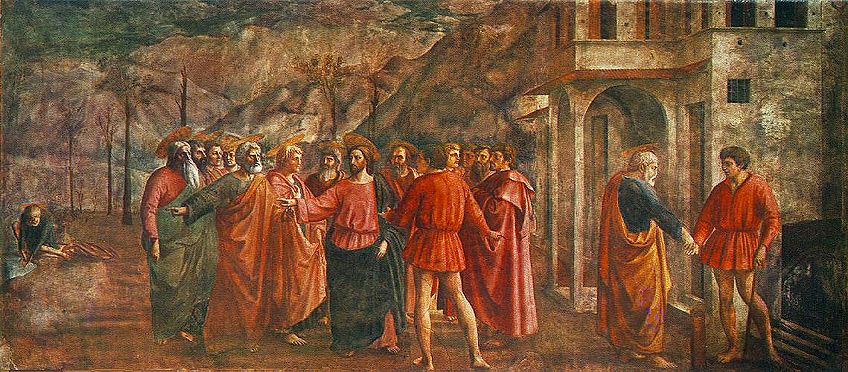
The Tribute Money (1426-1427) by Masaccio; Masaccio, Public domain, via Wikimedia Commons
Masaccio utilizes perspective here in the building and mountains, which recede into the background, giving a sense of spatial awareness and three-dimensionality. The figures also appear Classical in their clothing and stances.
All of these elements converge to give the painting a sense of realism, completely moving away from flat two-dimensional space. We are almost a part of the scenes as Masaccio brings to life the harmony inherent in all the elements of space, color, and perspective working together, possibly leaving the actual storyline as a secondary focus.
More Early Renaissance Artists
Other artists from the Early Renaissance include Piero della Francesca. One of his famous artworks is The Flagellation of Christ (c. 1455), wherein he skilfully utilizes lines of perspective in the painted architectural structures that divide the interior with the exterior spaces. There is also Allesandro Botticelli, whose La Primavera (1477 to 1482) and Birth of Venus (c. 1486) are some of the most famous paintings to this day, depicting the mythological goddess Venus.
We also see the turn away from naturalism in the figures and a focus more on the portrayal of beauty and aesthetic value.
We also have artists like Fra Filippo Lippi, Fra Angelico, and Paolo Uccello, the latter of whom was well-known for his detailed focus on perspective. In his famous painting series, The Battle of San Romano (c. 1450) we see the raging battle of the Florentines against the Sienese armies. Here, we see more than just a battle, but also the elegant arrangement of color and lines. In the foreground, there are bolder colors like blues and reds, even whites, that jump out at us. The lances bordering the composition also act as lines guiding our eyes towards the background, where we are further guided by the foliage and trees creating borders on the lands.
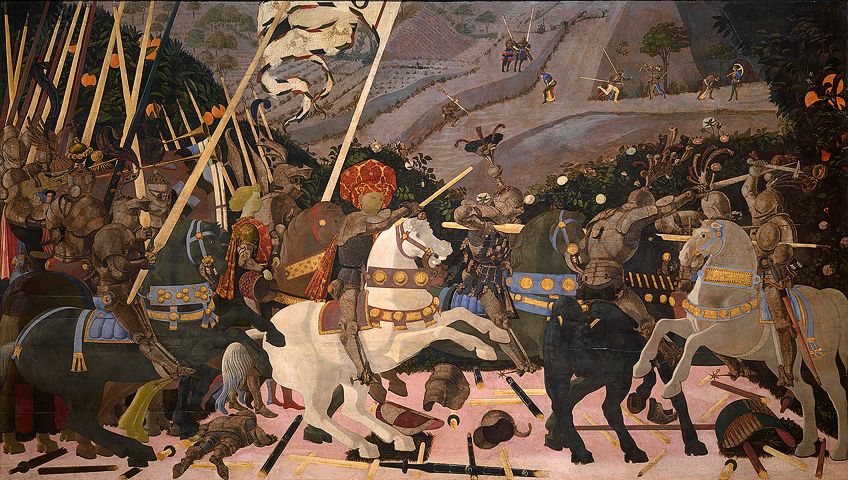
High Renaissance
While the Early Renaissance was centered in Florence, the High Renaissance was mainly in Rome, under the rule of the Catholic Church and the Pope. It started around 1495 to 1520 and was the cultural culmination of artistic virtue. During this time, artists (painters, sculptors, and architects) refined techniques during the earlier periods, created new techniques, and also used new media like oils, which gave painting a completely different effect.
Just like the Early Renaissance, there were three big names in the High Renaissance. Although there were also other great artists, most of us are familiar with what Leonardo da Vinci, Michelangelo, and Raphael brought not only to the art world, but the whole world.
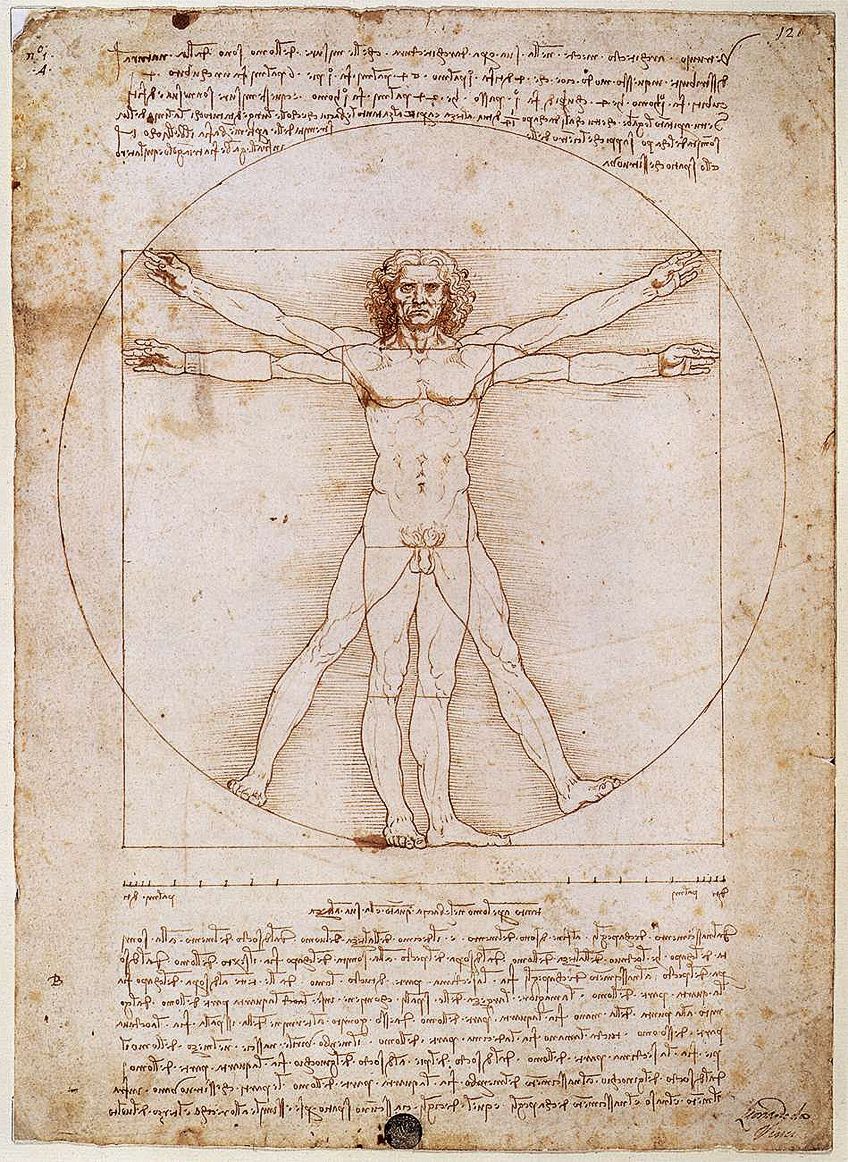
While there was a focus on realism in painting, there was also a desire to return to the values of beauty and harmony from the Classical era. The ideas of Humanism took one step further and introduced the “Universal Man” or “Renaissance Man” (Da Vinci was regarded as a “Renaissance Man”).
Beauty was depicted in the human form, which made it almost divine in its appearance. Also, conversely, the emotional realism depicted in divine and saintly figures gave them a human-like quality.
There was perfection in how artists rendered their subject matter with detailed anatomical correctness. Artists introduced new techniques like sfumato and developed techniques like quadratura, which refers to the illusionistic paintings on ceilings.
Leonardo da Vinci (1452 – 1519)
Leonardo da Vinci was a polymath, a man of many skills and talents. He was a painter, sculptor, designer, engineer, sketcher, scientist, and inventor. He utilized techniques like sfumato and chiaroscuro at a higher level, giving his paintings elaborate depth and a mysterious quality.
Some of his famous paintings include the Mona Lisa (La Gioconda) (c. 1503), Virgin of the Rocks (1483 to 1486), Lady with an Ermine (1489), The Vitruvian Man (c. 1485), The Last Supper (1498), Salvatore Mundi (1500), and drawings such as Portrait of a Man in Red Chalk (1512), Embryo in the Womb (c. 1510 to 1512), The Virgin and Child with St. Anne and St. John the Baptist (c. 1491 to 1508).
One example of Da Vinci’s genius-level skill is in his painting The Last Supper. This painting depicts Christ as the central figure, sitting at a long horizontal table with his disciples next to him. Behind him are three vertical windows, with the central window directly behind Christ, almost acting like a halo framing the top of his head. Along the walls, we also see vertical rectangular openings that lead our gaze to the vanishing point.
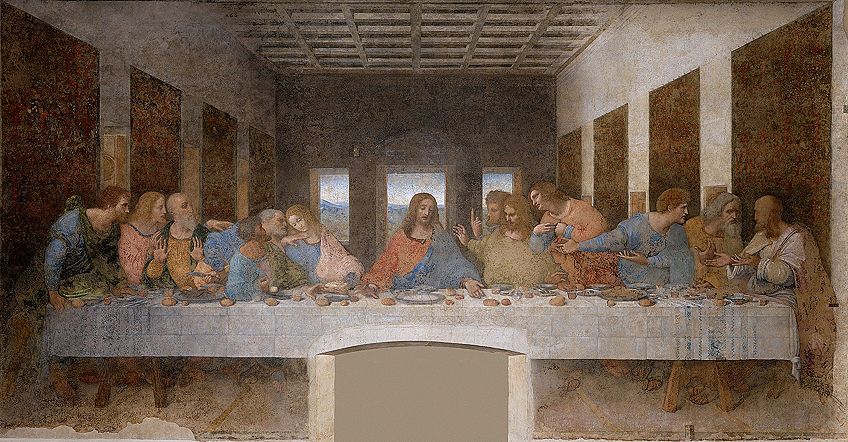
Da Vinci constructed this painting in perfect alignment with the linear perspective system, with all the lines converging to emphasize the central figure of Christ. The windows indicate an almost idyllic-looking mountainous green landscape outside.
It is in Virgin of the Rocks where we notice how da Vinci uses chiaroscuro and sfumato to emphasize the contrasts of light and dark. We see this shifting of shadows and light especially in the skin of the central figures of Mother Mary with two infants, namely, Jesus Christ and John the Baptist. To the right is the accompanying figure of archangel Gabriel.
The setting is mysterious. We see the figures surrounded by rocks – they could possibly also be sitting in a cave. The left side of the composition opens out to a landscape of winding water and more mountainous, rock-like formations. In the foreground, in front of the figures, there are some flowers and foliage. The figures are also arranged in a characteristic pyramidal shape.
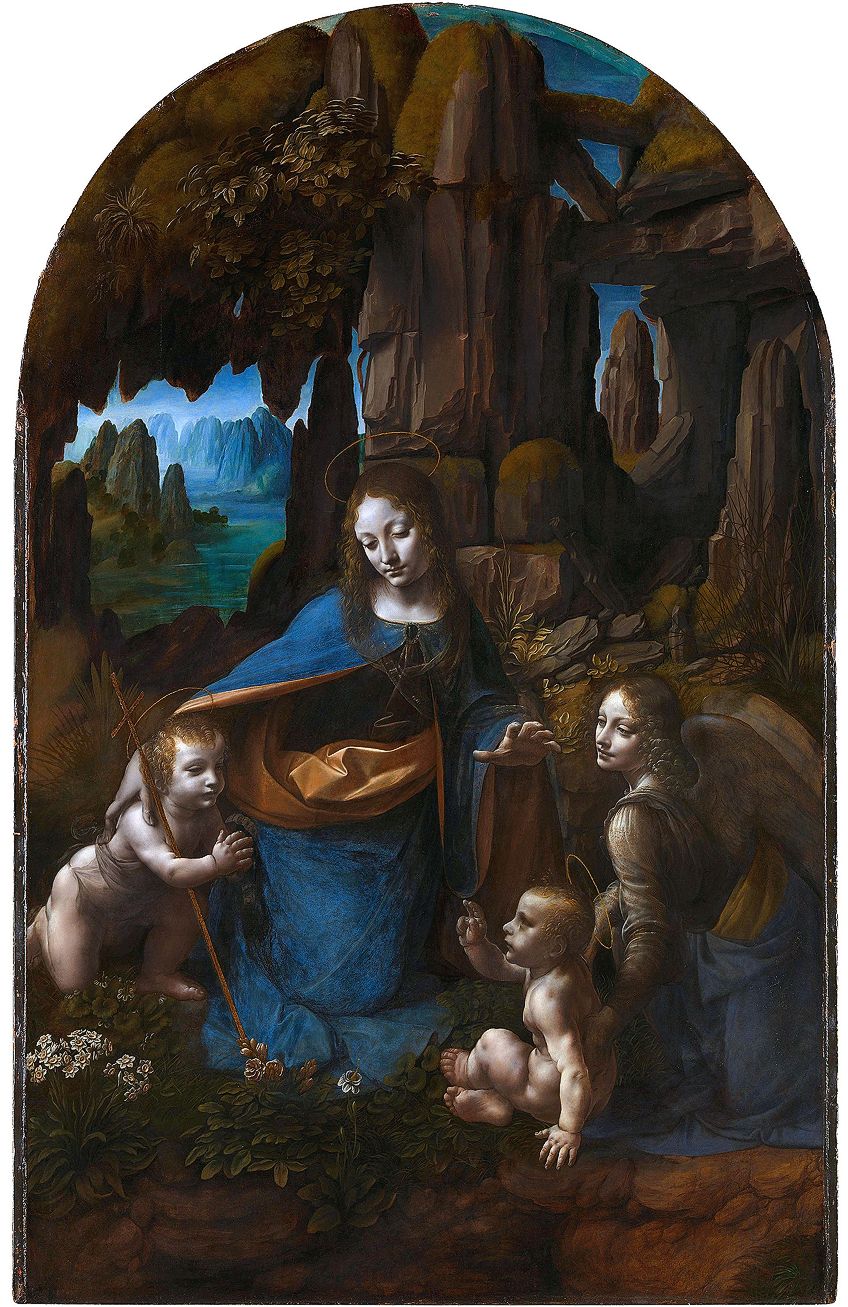
When we look at the facial expressions in each figure, there is a sense of humanness in them. We can see emotional states as well as a sense of calm. Their gestures also give the painting a sense of movement and a deeper meaning to the narrative.
We notice this emotive expression on da Vinci’s Mona Lisa too, although her facial features offer a faint smile, giving the whole composition a mysterious quality. Her eyes are soft in their gaze, creating a sense of calmness. Behind her is another watery and rocky landscape, which is often said to be imaginary, like the landscape in Virgin of the Rocks.
Again, da Vinci creates realism with the sfumato and chiaroscuro techniques, which we can see in Mona Lisa’s skin tones, as well as the gradation of colors and light in the background. In the foreground, there are darker tones that also gradually light up her resting hands.

Michelangelo (1475 – 1564)
Michelangelo di Lodovico Buonarroti Simoni, also known as Michelangelo, was born in the Caprese village of Tuscany, Italy. He was responsible for the famous paintings on the Sistine Chapel’s ceiling, namely, The Creation of Adam (1508 to 1512) and The Last Judgment (1536 to 1541). Pope Julius II commissioned Michelangelo’s first painting as part of his project to repaint the chapel’s ceiling. Pope Clement VII and Pope Paul III commissioned Michelangelo’s second painting, The Last Judgement.
Michelangelo was famous for his realistic portrayals of the human anatomy; we see this in his figures from the two abovementioned paintings.
The Creation of Adam depicts Adam to the left reaching out to the outstretched arm of God to the right. Both figures are portrayed as strong and muscular in appearance, with specific emphasis on the outlines of most of the major muscle groups.

In Michelangelo’s famous sculptures, Pietà (1498 to 1499) and David (1501 to 1504), we see his mastery of marble. He was also known for carving a sculpture out of one block of marble. In Pietà, we see the same characteristic pyramidal format that we saw in da Vinci’s Virgin of the Rocks, although here, it is the Mother Mary holding the body of Christ on her lap.
The two figures are portrayed with a serene emotional quality, evident in their facial expressions, which is unlike the more stricken facial expressions of similar subject matter created by other artists. We also see the artist’s skill in the way he depicts the clothing – it appears almost real and diaphanous in the way it flows and drapes around the base of Mother Mary.

In David, Michelangelo creates the biblical figure of David almost to perfection. There is an advanced eye for detail in the musculature. Furthermore, David stands in the contrapposto stance, which further gives him a sense of movement and realism, reminiscent of the statues from the Classical era. The statue stands at 17 feet tall.
Other sculptures by Michelangelo include Bacchus (1496 to 1497), Madonna and Child (Madonna of Bruges) (1501 to 1504), Moses (1513 to 1515), which is part of the tomb for Pope Julius II, Crouching Boy (1530 to 1534), and The Deposition (1547 to 1555), among many other sculptures, both finished and unfinished.
Raphael (1483 – 1520)
The paintings by Raffaello Sanzio da Urbino, or just Raphael, had more harmonious qualities to them. In other words, while he utilized the characteristic techniques we see in many Renaissance paintings, Raphael is known for depicting his compositions with an elegance and “clarity” that set him apart.
Born in Urbino, a city in Italy, Raphael was another multi-talented artist of the time. He was a painter, architect, draftsman, and printmaker. He produced numerous paintings in his life, some of which are frescoes held in the Raphael Rooms in the Apostolic Palace in Vatican City. The paintings were also commissioned by Pope Julius II.
Raphael’s most famous fresco, School of Athens (1509 to 1511), depicts the Classical philosophers Plato and Aristotle as the central figures, surrounded by many other philosophers either in deep discussion with one another or in deep contemplation with themselves.
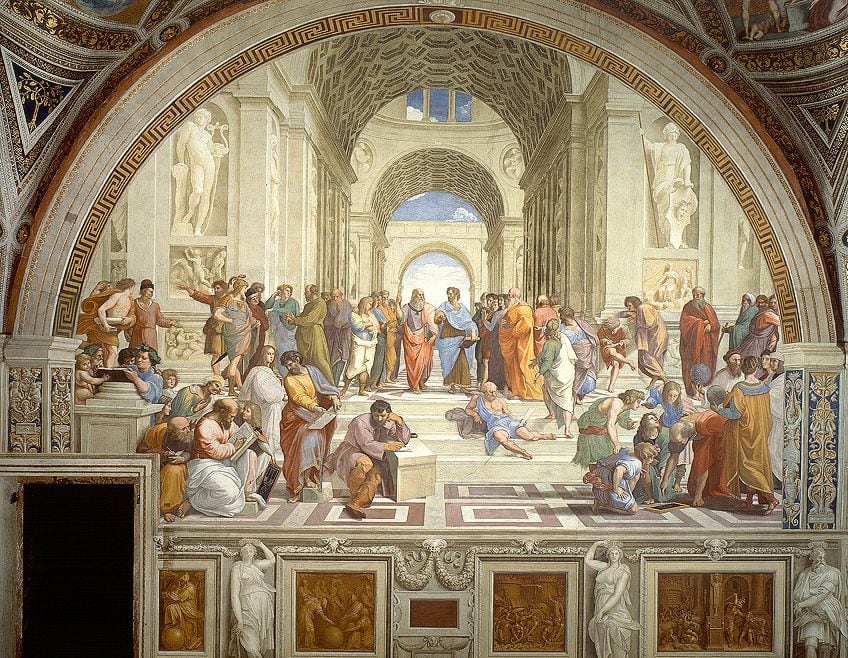
Raphael depicted the scene to appear as though we can walk into it at any moment. In the foreground, there is an architectural arch framing the painting, and our viewpoint gradually moves towards the two central figures. Behind them are more architectural arches that lead to the exterior, which is a clear blue sky with dollops of white clouds. The colors are also subdued and not too bright, which makes the composition more inviting and easier to take it all in.
We see Raphael’s skillful utilization of perspective and color to create a harmonious composition reminiscent of the Classical era’s style.
Other paintings by Raphael include the Wedding of the Virgin (1504), Disputation of the Holy Sacrament (1510), The Parnassus (1511), Sistine Madonna (1512), Triumph of Galatea (1514), La Fornarina (1520), and The Transfiguration (1520).
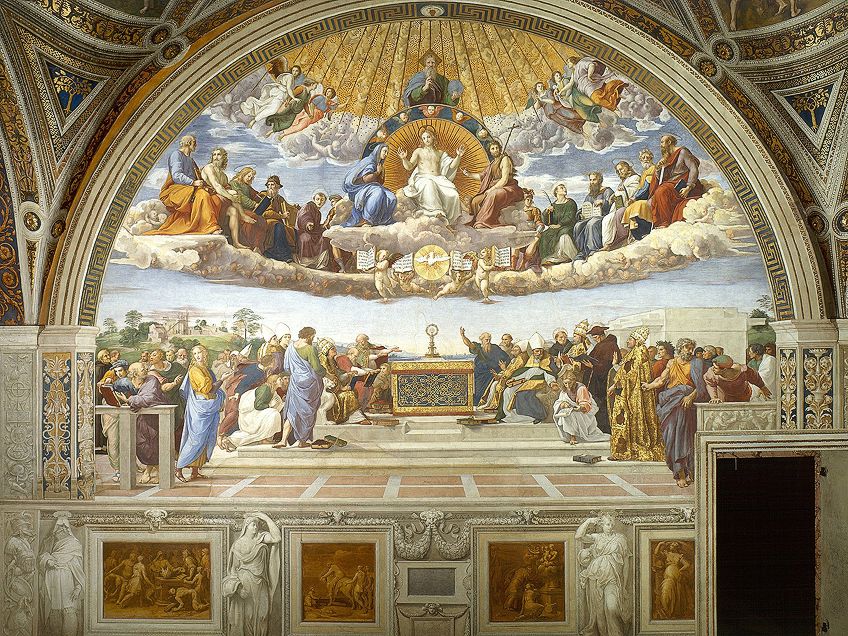
More High Renaissance Artists
Other High Renaissance painters include Antonio Correggio, who created the Assumption of the Virgin (1526 to 1530) in the Parma Cathedral. This highly skilled illusionistic fresco on the dome ceiling of the cathedral appears as if heaven is opening on the ceiling.
Donato Bramante was another great architect during this period, who was known for finding the architectural style of the High Renaissance and was regarded in high esteem. He was part of the group of architects (Michelangelo and Raphael) who returned Rome’s architecture to what it was from the Roman times.
He was commissioned by Pope Julius II to recreate St. Peter’s Basilica, which had been a Constantinian building previously. He was also involved in creating various new structures that would elevate the city of Rome and the Vatican.
Northern Renaissance Art
Northern Renaissance art started around the 1430s to 1580s in countries like Belgium, the Netherlands, and Germany. This period was markedly different from the Italian Renaissance discussed above – it did not emulate the Classical era’s virtues but was mostly influenced by the Gothic style of art.
When we compare the Italian to the Northern Renaissance, characteristic words describe each period . For instance, the Italian side was “dreamy” and “idealized” whereas the Northern side was “down-to-earth” and “practical”.
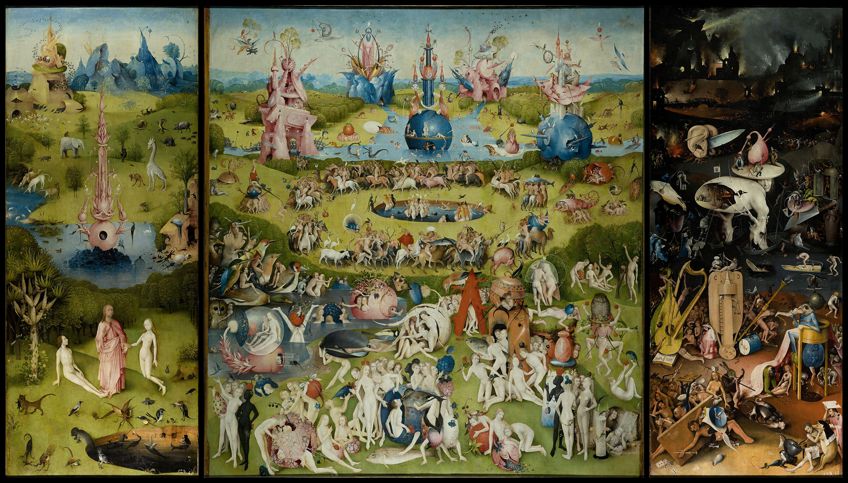
Oil paint was utilized to convey a deep realism in the subject matter, where all the details were painted clearly and objectively. This was done on panel paintings and altarpieces in religious buildings. Due to the historical shifts of the time, mainly from the Protestant Reformation, artists did not approach their subject matter in the same way as that of Italian artists.
The subject matter of the Northern Renaissance included more everyday objects and lifestyles, often with moral messages. This was in opposition to the idealized forms for the Catholic Church, which were seen as iconographic in nature. Some of the genres of painting included landscapes, still lifes, and portraits. Paintings were also smaller and not done on as large a scale as in Italy, where they were mainly displayed for public purposes in churches.
Furthermore, there was extensive utilization of woodblock printing and illuminated manuscripts. The creation of the printing press was a revolutionary development, enabling a widespread dissemination of books, pamphlets, prints, and engravings.
Jan van Eyck (1390 – 1441)
One of the popular artists during this time includes Jan van Eyck, who produced the famous Ghent Altarpiece (1431), which is considered to be the pioneering artwork that paved the way for Northern Renaissance art. It was famous for its in-depth realism and how the artists utilized oils as the medium of painting to an expert level, which further contributed to the realism.
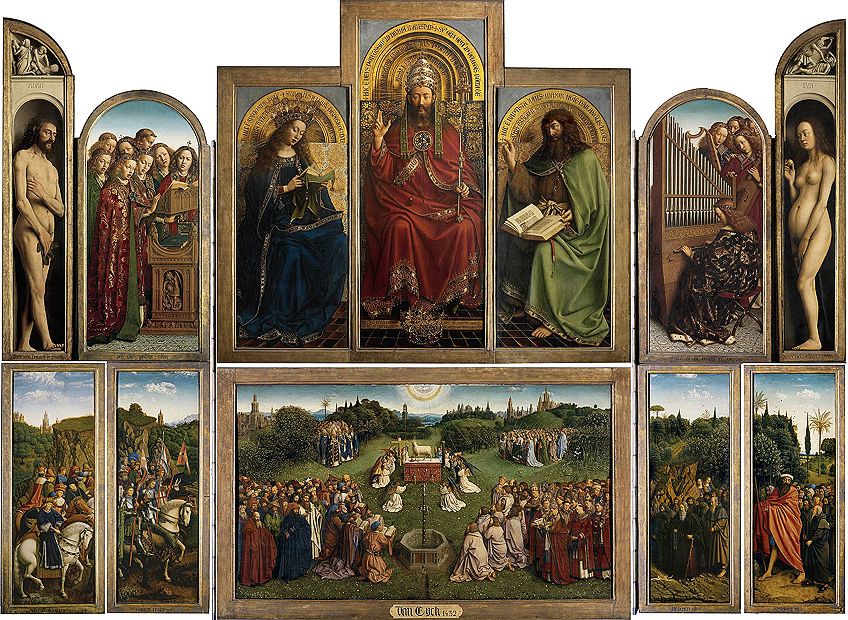
The Ghent Altarpiece is a polyptych (a painting or altarpiece consisting of more than three panels) depicting a rich religious narrative, often considered mysterious because of all the religious figures and who they are in the composition.
Other works by v an Eyck include Arnolfini Portrait (1434), which is another of his famous pieces depicting the businessman Giovanni di Nicolao Arnolfini and his wife. Again, we notice the detailed realism obtained through the artist’s application of several layers of glaze, thus enhancing the colors even more.
Albrecht Dürer (1471 – 1528)
Albrecht Dürer was another important artist during this period because of the way he amalgamated the naturalistic realism style from the North with the theories of proportion, balance, and Humanism from the Italian Renaissance. He also explored the theories of perspective from a scientific point of view and wrote several publications exploring this, namely the Four Books on Measurement (1525), Treatise on Fortification (1527), and the Four Books of Human Proportion (1528).
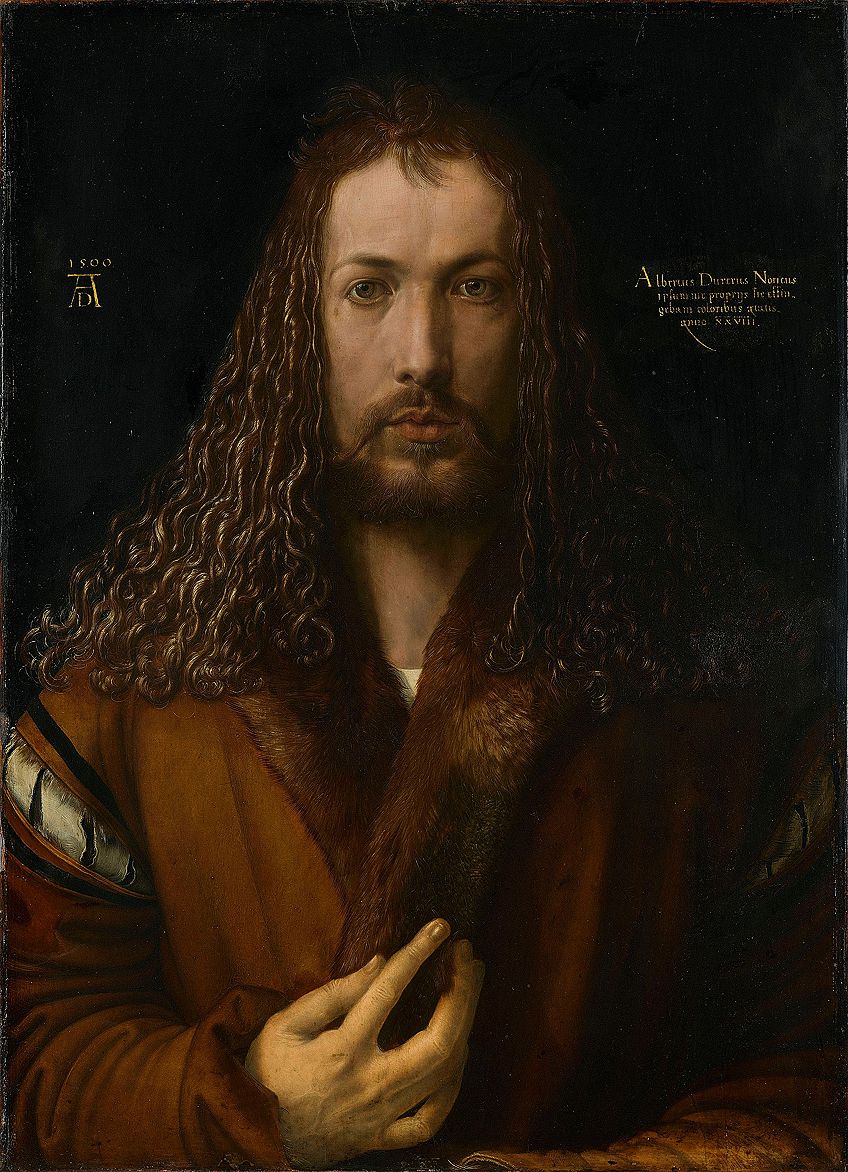
Some of Dürer’s artworks include his famous Self-Portrait (1500), which depicts the artist looking directly at us, the viewers. We see his right hand lifted with two fingers, appearing as the classical gesture of blessing we so often see in religious paintings.
In fact, this painting is thought to depict the artist portraying himself as Christ, with his long, curly hair also contributing to that likeness. Along with the darkened background, this painting hints at a Medieval essence.
Hare (1502) is another example of Dürer’s skill as an artist. It depicts a hare, painted in detail and in watercolor, showcasing the artist’s close study of nature. The white background also indicates a more scientific observation rather than the focus on painting a religious object. The hare appears relaxed and still, but there is also a sense of movement, with the hare’s hind legs perched in readiness to jump away if someone were to approach it.

More Northern Renaissance Artists
Other Northern Renaissance artists include Robert Campin, Hieronymus Bosch, Pieter Bruegel the Elder, and many more who painted everyday lives and people. This period came to an end because of various political hardships, such as the Eighty Years War (1568). The Dutch Golden Age also revisited aspects and techniques from the Northern Renaissance, continuing its legacy.
Modern art movements like Impressionism, Post-Impressionism, Cubism, and Surrealism also drew inspiration from this period and the genres that developed from it. Some scholars also say that this period and its artists like van Eyck, Dürer, Bosch, and Bruegel, were more influential than the Italian Renaissance.
After the Rebirth: A Matter of Mannerism
As the Renaissance ended as the main cultural and artistic movement in Europe, the art movement called Mannerism began to develop around the 1520s. Artists felt the High Renaissance in Italy had achieved all it could, and they did not focus on building upon it. Instead, artists created a new style that was more expressive, asymmetrical, and unperturbed by the perfection and proportions so meticulously ascribed to by the Renaissance painters.
Take a look at our Renaissance art characteristics webstory here!
Frequently Asked Questions
What Is the Renaissance Timeline?
The Renaissance was a cultural, societal, and political shift in European history after the Medieval ages. It was a “rebirth” and considered an age of discovery and exploration in many disciplines like art, science, mathematics, technology, astronomy, music, literature, philosophy, architecture, and more. It started around the 14th Century and ended around the 17th Century. The Italian Renaissance timeline is divided into the Proto-Renaissance, Early, and High Renaissance, along with its counterpart in the Northern European countries.
What Characterized Renaissance Art?
Renaissance art in Italy started depicting more realism in its subject matter and moved toward more naturalism. Artists also drew inspiration from the Classical era of Greek and Roman art and its values of harmony and proportion. Although artists focused on religious subject matter, man was also considered an important part of the world, and this was reflected in the Humanism philosophy. New techniques and media were also utilized to create more three-dimensionality, for example, oil paints, linear perspective, sfumato, and chiaroscuro, among others.
Who Were the Main Renaissance Artists?
During the Proto-Renaissance, the pioneering artists were Cimabué and Giotto. During the Early Renaissance artists like Brunelleschi, Masaccio, and Donatello developed new techniques in painting, sculpture, and architecture. During the High Renaissance, Leonardo da Vinci, Michelangelo, and Raphael were considered the three greats who refined many techniques from the previous periods. Artists like Albrecht Dürer, Jan van Eyck, Pieter Bruegel the Elder, and Hieronymus Bosch were well-known during the Northern Renaissance.
Isabella studied at the University of Cape Town in South Africa and graduated with a Bachelor of Arts majoring in English Literature & Language and Psychology. Throughout her undergraduate years, she took Art History as an additional subject and absolutely loved it. Building on from her art history knowledge that began in high school, art has always been a particular area of fascination for her. From learning about artworks previously unknown to her, or sharpening her existing understanding of specific works, the ability to continue learning within this interesting sphere excites her greatly.
Her focal points of interest in art history encompass profiling specific artists and art movements, as it is these areas where she is able to really dig deep into the rich narrative of the art world. Additionally, she particularly enjoys exploring the different artistic styles of the 20th century, as well as the important impact that female artists have had on the development of art history.
Learn more about Isabella Meyer and the Art in Context Team.
Cite this Article
Isabella, Meyer, “Renaissance Art – Europe’s Cultural Rebirth.” Art in Context. June 25, 2021. URL: https://artincontext.org/renaissance-art/
Meyer, I. (2021, 25 June). Renaissance Art – Europe’s Cultural Rebirth. Art in Context. https://artincontext.org/renaissance-art/
Meyer, Isabella. “Renaissance Art – Europe’s Cultural Rebirth.” Art in Context, June 25, 2021. https://artincontext.org/renaissance-art/.


